Peace lily flowers changing to brown, green, or black are a cause for concern. These changes usually mean your plant needs a bit of help. Peace lilies are generally easy to care for, but they can show stress if their needs aren’t perfectly met.
This guide will explain why your peace lily might be having color problems and how to fix them. You’ll find out about the right light, water, and nutrients to keep your plant healthy and blooming beautifully. We’ll discuss everything from too much sunlight to the best way to fertilize.
If you’re ready to restore your peace lily’s vibrant look, keep reading. We’ll provide tips and tricks to keep your plant lush and green, with beautiful white flowers all year round.
- Related article: Grow and Care for Peace Lilies
6 Key Takeaways on Peace Lily Flowers Turning Brown, Green, and Black
1. Peace lily flowers turning brown often happens because they’re getting too much direct sunlight. This sunlight scorches the leaves. You should move your peace lily to a spot with bright, indirect light instead.
2. If you notice your peace lily flowers changing to green, it might be getting too much fertilizer. Cut back on the fertilizer for a while to help your plant bounce back.
3. Don’t worry if you see black flowers on your peace lily. This is usually just the flowers aging and is a normal part of the plant’s life cycle.
4. For your peace lily to thrive, it needs bright, filtered light. This kind of light prevents leaf burn and helps the plant grow well.
5. The soil should be moist but not soggy. Overwatering can cause root rot and make the leaves yellow.
6. Peace lilies love humidity. If your home is dry, think about using a humidifier or placing a tray of water near the plant to keep the air around it moist.
Why Do Peace Lily Flowers Turn Brown?
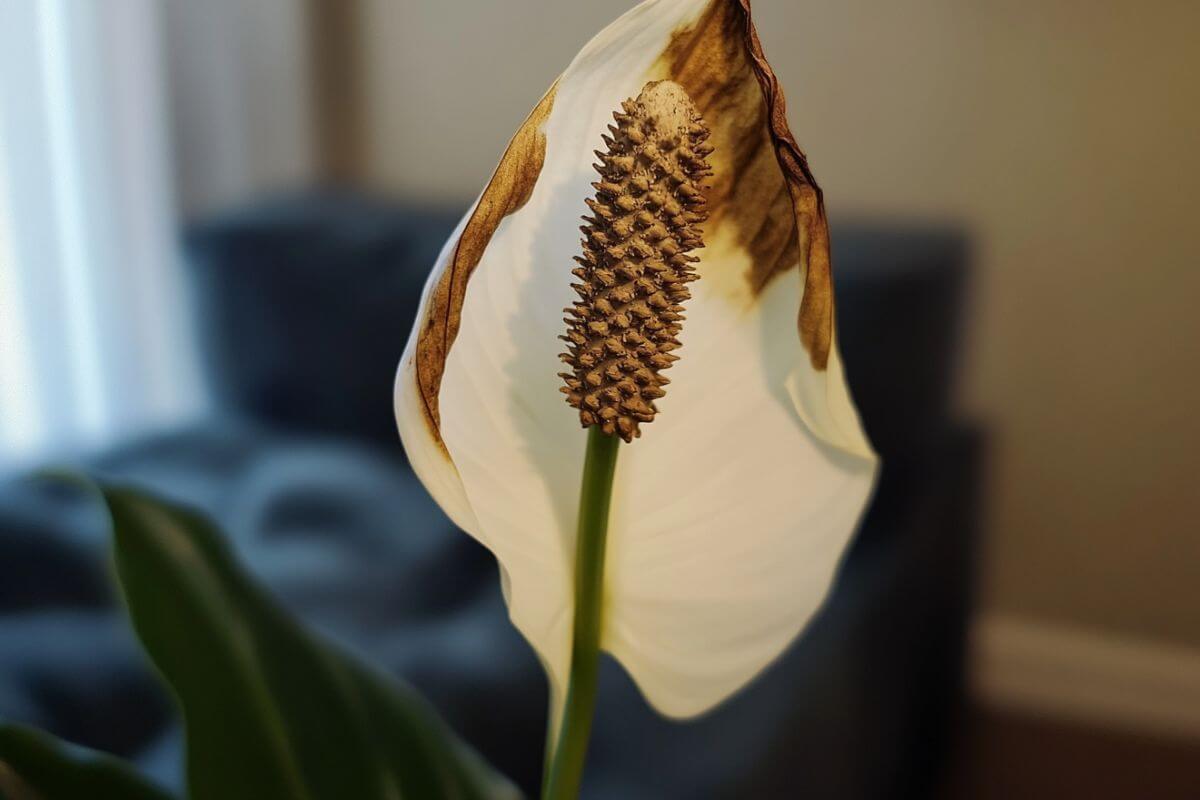
The most common reason peace lily flowers turn brown is that they receive too much direct light. Direct sunlight can scorch the leaves of a plant, causing them to burn up.
This will cause the leaf tips to turn yellow and then eventually brown. The browning process may take several days depending on how intense the sun exposure was.
If this happens, remove all affected parts of the plant including the roots. You don’t want any part of your peace lily dying, so make sure to keep it watered until new growth appears.
Other reasons for peace lily flowers turning brown include:
- Too little water
- Fertilizer not applied properly
- Poor drainage in the garden bed
- Lack of air circulation around the base of the plant
- Insects feeding on the foliage
- Disease such as powdery mildew
Why Do Peace Lily Flowers Turn Green?
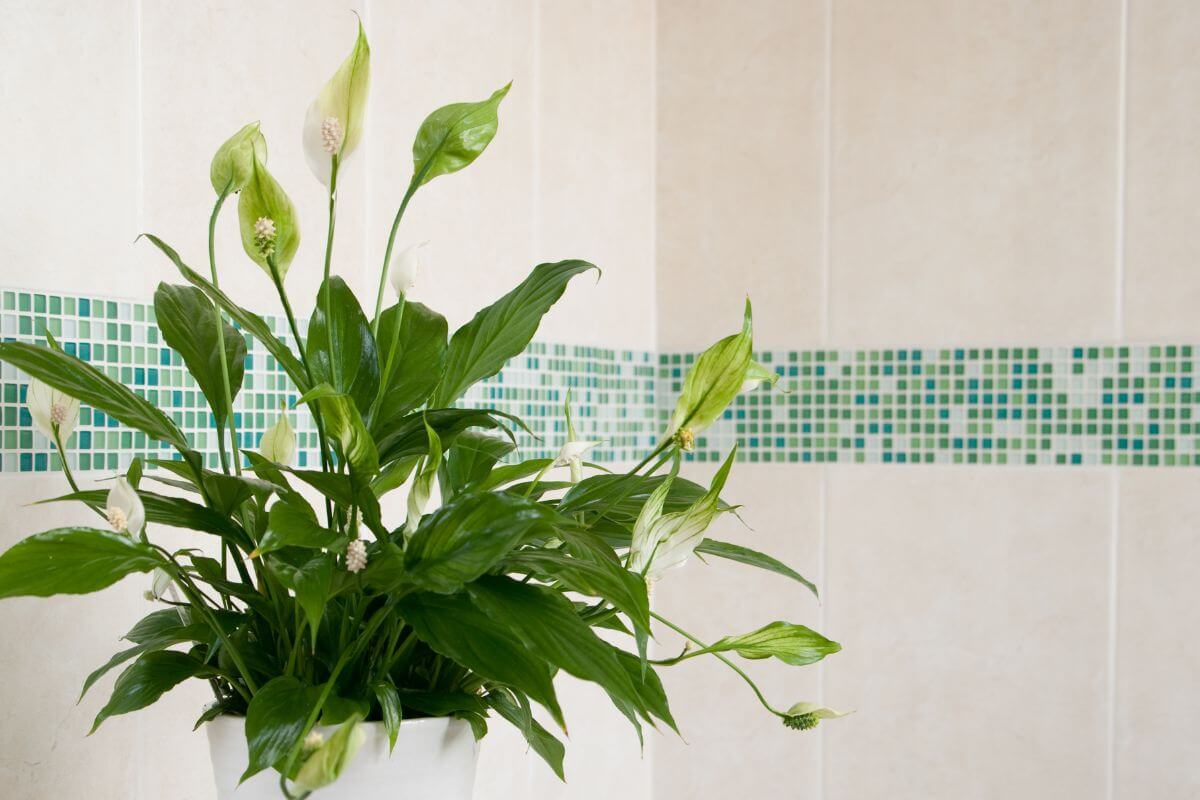
If you see peace lily flowers turning green, it’s most likely because of too much fertilizer. Other signs of over-fertilization include excessive blooms with no stems, wilting leaves, and stunted growth.
You’ll need to stop applying fertilizer immediately if these symptoms appear. If you’ve been using high nitrogen fertilizer like fish emulsion, try switching to one containing lower levels of nitrogen.
Once you have stopped adding fertilizer, wait at least two weeks before reapplying. This gives the plant time to recover and grow strong again.
Other reasons the peace lily flowers turn green:
- Excessive watering
- Waterlogged soil
- Low humidity
- High temperatures
- Drought stress
- Nutrient deficiencies
- Root rot
- Parasites
- Diseases such as bacterial wilt
Why Do Peace Lily Flowers Turn Black
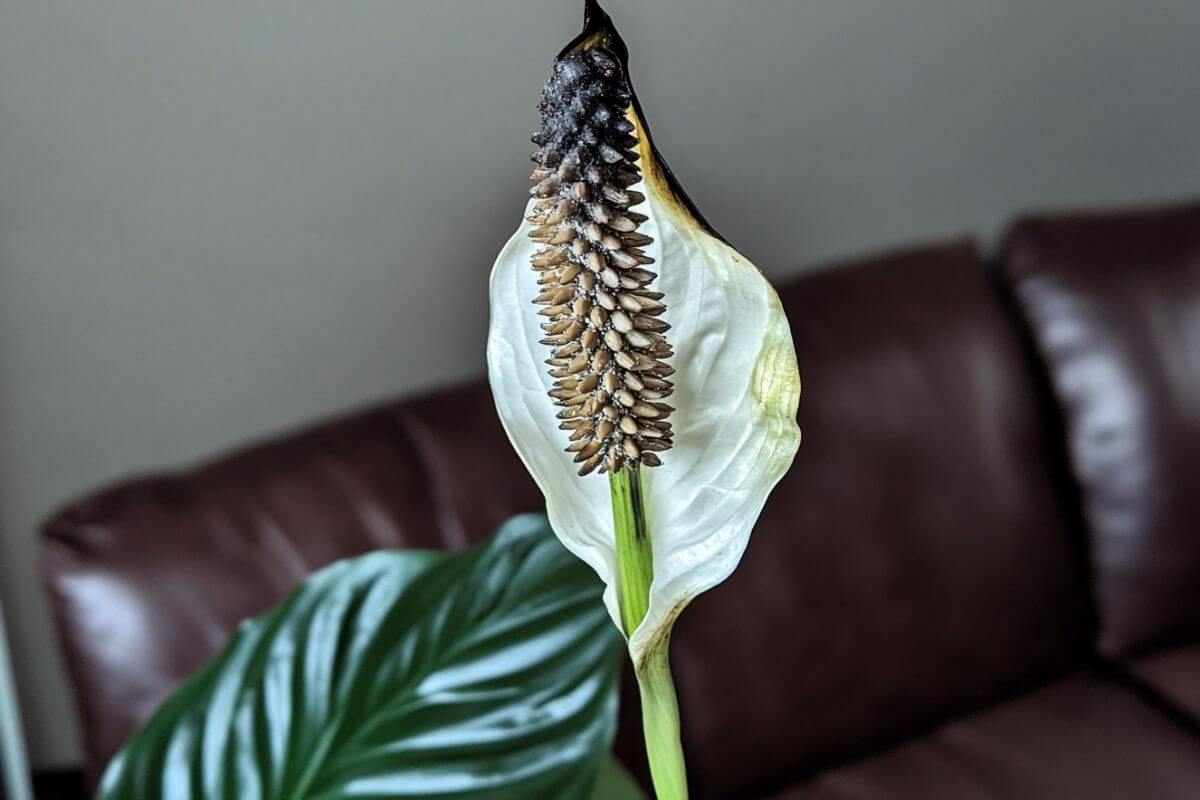
When peace lily flowers turn black, the most common reason is due to the age of the flower. They usually have a lifespan that lasts between a week and a month. As soon as the petals start falling off, the stem starts drying out which causes the rest of the flower to shrivel up and die.
It doesn’t matter whether the flower has just opened or already started opening; once the petals fall off, the life cycle ends.
To lengthen the peace lily lifecycle of the blooms, proper care of the peace lily is required.
Keep the peace lily well-watered during dry periods. Water deeply enough to ensure there isn’t standing water near the root zone.
Avoid overwatering because excess moisture encourages disease development. It also promotes fungal diseases that attack the roots.
How to Prune Damaged Peace Lily Flowers and Leaves?
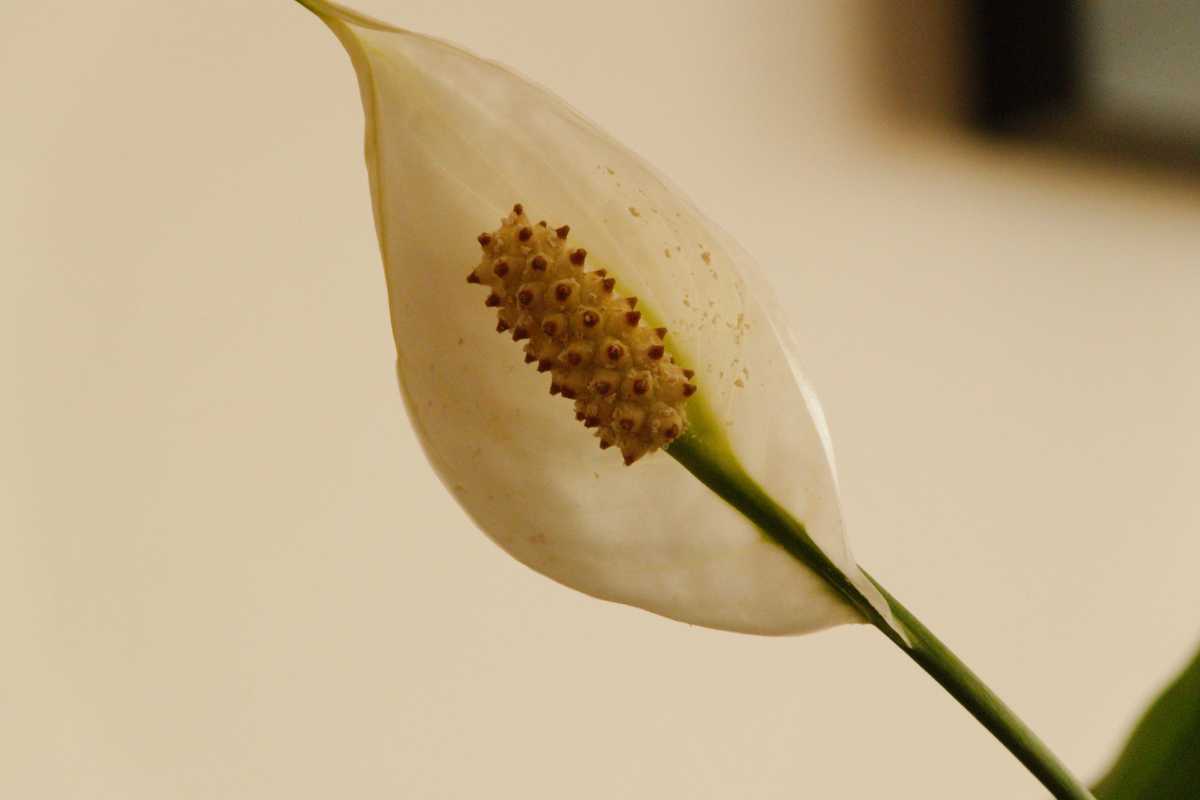
After the flowers turn brown, black or green, they unfortunately won’t recover. What you will want to do is to prune away the colored parts from the plants.
When cutting, be sure to use a good pair of clean, pruning shears
Cut back the damaged portions by about half their length. Don’t cut right down to the ground but rather leave some stubby pieces remaining. These are called “stubs” and should be left intact.
Make sure to clean up any debris after cutting back the damaged areas. Remove weeds and other unwanted vegetation from the area where the peace lilies were growing.
How to Prevent Discoloration in Peace Lily Flowers
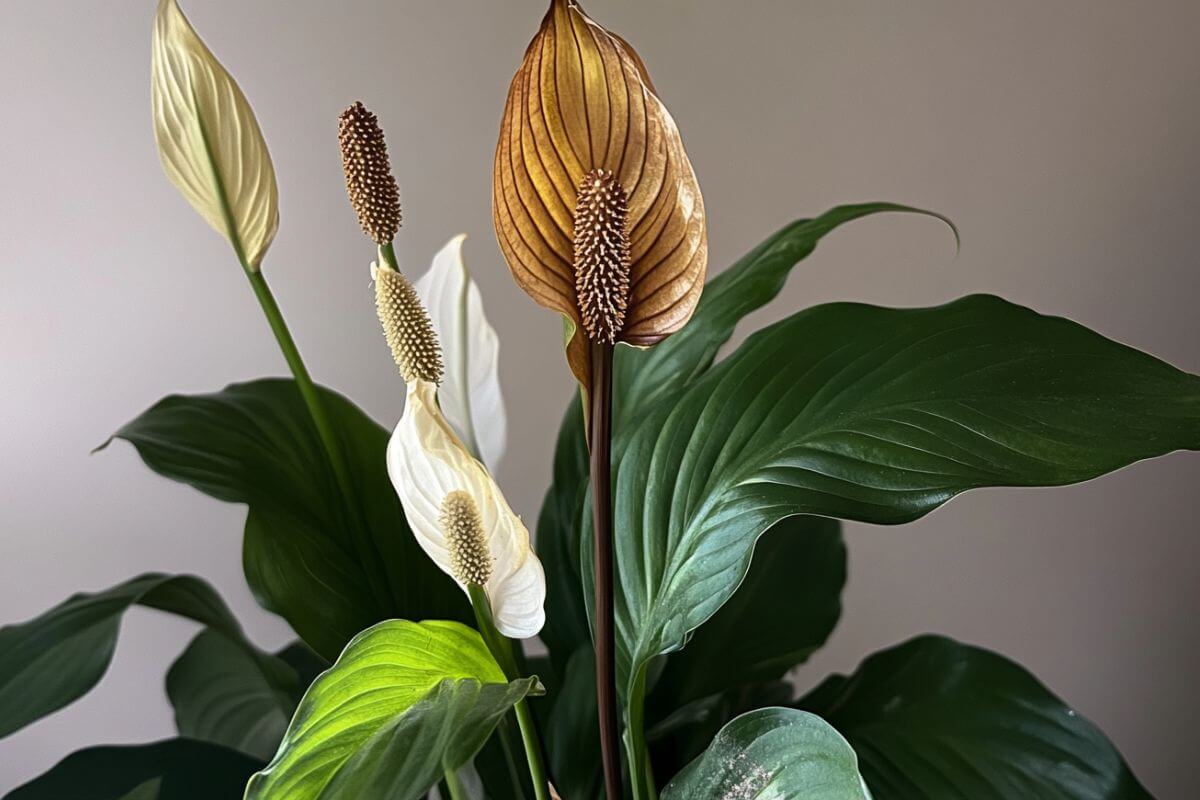
To keep peace lily flowers vibrant and free from discoloration, a few key care practices can make all the difference. From providing the right light and humidity to proper watering and soil quality, each factor plays a role in preventing browning or yellowing flowers. By adjusting your plant’s environment and giving it the care it needs, you can enjoy a healthy, blooming peace lily year-round.
1. Provide Indirect Light
Peace lilies thrive when placed in a spot where they can soak up indirect sunlight. It’s all about that bright, filtered light! I once made the mistake of putting mine in direct sunlight, and the leaves ended up scorched with brown spots. Trust us, finding the right light makes a world of difference.
2. Monitor Watering Practices
Water your peace lily thoroughly until you see water draining from the bottom, then let the top inch of soil dry out before watering again. Overwatering is sneaky—it can turn leaves yellow and lead to root rot, which you could learn the hard way!
3. Check Humidity Levels
Peace lilies love a bit of humidity! If your home feels dry, use a humidifier or set a tray of water nearby. This little trick keeps the humidity levels up and helps prevent those pesky browning leaves. It’s especially helpful in the winter months when the air is drier.
4. Use Balanced Fertilizer
During the growing season, feed your peace lily with a balanced 20-20-20 fertilizer every 6-8 weeks.Take note that overfertilizing may result in leaf burn. So, always keep an eye on the amount you use—it really keeps the plant looking vibrant and healthy.
5. Use Proper Soil Quality
Choosing the right potting mix has been a game-changer for me. Make sure to use a high-quality mix that retains moisture but also allows for good drainage. Poor soil quality can lead to nutrient deficiencies, and you may see the effects firsthand in the form of brown leaves. Investing in good soil pays off!
6. Adjust Light Conditions
If you notice brown flowers or spots on leaves, it could mean your peace lily isn’t getting enough light. You may need to do some adjustments now and then, moving it closer to a light source while still ensuring it avoids direct sunlight.
7. Prune Damaged Leaves
Remove any brown or damaged leaves from your plant regularly. It’s amazing how this simple act promotes new growth and enhances the overall appearance. It redirects energy to the healthier parts of the plant, making it look much more vibrant.
8. Avoid Temperature Extremes
Keeping my peace lily away from drafts and heating vents has been vital. Sudden temperature changes can stress the plant, leading to discoloration. Make it a point to find a cozy spot that’s temperature-friendly, and my plant has thrived because of it!
9. Inspect for Pests
We can’t stress enough how important it is to check for pests. Spider mites and aphids love to sneak up on peace lilies. Inspect your plant regularly and treat any infestations promptly with insecticidal soap or neem oil to keep those beautiful flowers healthy and blooming.
10. Repot When Necessary
When your peace lily becomes root bound, it could be time to repot it into a slightly larger pot with fresh soil. This small step encouraged healthy growth and prevented issues like yellow leaves or brown spots. It’s a simple way to give your plant a fresh start!
Peace Lily Flower Discoloration Final Thoughts
To keep your peace lily healthy and full of life, focus on four main things: light, water, humidity, and soil. Place your plant where it gets indirect sunlight. Make sure the soil is moist but not too wet. This helps stop problems like brown leaves and flowers losing their color. Check the humidity often and feed your plant with a balanced fertilizer to help it grow.
It’s also important to cut off any damaged leaves and look for pests regularly. If you see any discoloration, fix the problem quickly. With the right care, your peace lily will thrive and give you beautiful white flowers all summer. Just remember, paying a little attention to your peace lily makes a big difference in keeping it healthy!
Peace Lily Flower Discoloration FAQs
1. Why Are My Peace Lily Flowers Turning Brown?
Brown flowers on peace lily plants often indicate environmental stress. This can be due to temperature fluctuations, inadequate watering, or poor soil mix. Ensure your peace lilies are in moist soil and receive indirect light to prevent browning.
2. Can Indirect Light Cause Brown Leaves on Indoor Plants?
Yes, peace lily plants thrive in indirect light. However, if exposed to bright light, the leaves may turn brown. It’s crucial to keep your indoor plants in a well-lit area that avoids direct sunlight while ensuring they have moist soil for optimal health.
3. What Environmental Conditions Affect Peace Lily Health?
Peace lilies prefer humid environments. If they are in dry conditions or experience temperature fluctuations, they may develop brown or green leaves. Maintaining humid conditions and proper drainage can help your peace lilies flourish.
4. How Can I Improve My Peace Lily’s Soil Mix?
Using a poor soil mix can lead to issues like brown peace lilies. Opt for a well-draining potting mix that retains moisture but allows excess water to escape through adequate drainage holes. This balance is essential for healthy peace lily plants.
5. What Should I Do During Warmer Months for My Peace Lily?
During warmer months, peace lily plants may require more frequent watering to keep the soil moist. Monitor their environmental conditions closely and adjust their placement to ensure they are not exposed to direct sunlight, which can cause brown flowers and leaves.
For more houseplant articles, check these out:



